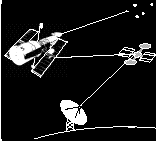Indoor/outdoor floodlights (red, green,
and blue)
Adjustable fixtures to hold the lights
Projection screen
Dark room
Procedure:
1. Prior to class, set up the three floodlights in a row at a distance of about 4 meters from the projection screen so that they each point to the center of the screen. The lights should be spaced about 1 meter apart. When properly aimed, the three lights should blend to produce a nearly white light falling on the screen. Move one or more lights closer to or farther away from the screen to achieve a proper balance.
2. With the room dark and the floodlights turned on, hold up your hand between the lights and the screen. Three colored shadows appear--yellow, cyan (a shade of blue), and magenta.
3. Move your hand closer to the screen. The shadows will overlap and produce additional colors--red, blue, and green. When all the shadows overlap, there is no color (light) left and the shadow on the screen becomes black.
4. Invite your students to try their "hand" at making shadows.

Discussion:
This activity extends the Color Recognition activity. It demonstrates how a few basic colors can produce a wide range of colors and hues. When the three lamps are set up properly, the screen appears whitish. When all shadows overlap, the shadows becomes black; black is the absence of light. In between white and black are the colors red, green, blue, cyan, yellow, and magenta. By moving the floodlights forward and back, a wide range of hues appear. Astronomical satellites that collect images in the optical range often use colored filters to take multiple pictures of the same object. Combining the different colored images approximates what we think the true colors are. Usually, though, astronomers use
